On Writing Villains: How to Write Complex, Compelling Antagonists
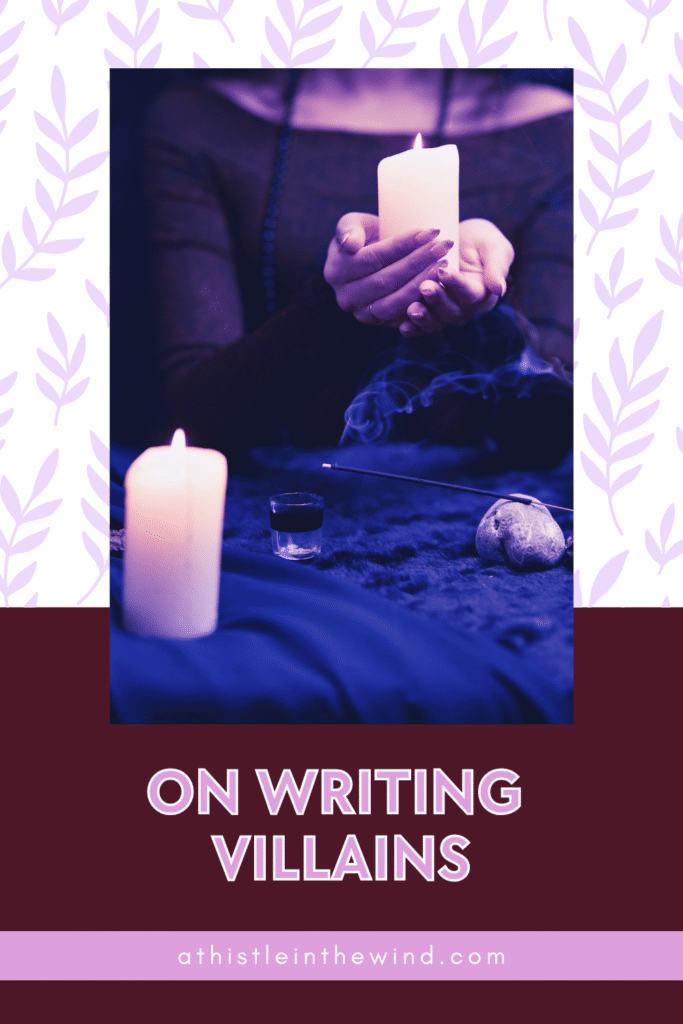
Last week, I wrote a blog on writing anti-heroes, so naturally, this week’s blog had to be on writing villains. Villains are interesting, to say the least. I personally like them, especially if they’re written well, or played by Benedict Cumberbatch.
Side Note: Did you SEE him in Star Trek? It’s been over a decade and god, he was good.
But my affinity to Benedict Cumberbatch aside, villains can be fun to write—if you write them correctly. I guess the real challenge with writing villains is just how easy it is to make them cartoony.
And this isn’t an uncommon problem or anything. Sometimes, I have a really good hero or anti-hero, and it’s so easy to just ignore the villain. But that would be wrong, and honestly, an injustice to both the character and your readers.
So, in this blog, I’m taking a closer look at villains: how to write them, how to breathe life into them, and, most importantly, how to make your antagonist the kind of character your readers will never forget.
The Anatomy of a Villain
Before you start writing a villain, it’s important to understand why they matter so much to a story in the first place. Generally speaking, a story is about how your main character changes—or doesn’t—when faced with pressure, conflict, and high stakes. That transformation doesn’t happen in a vacuum.
It happens because someone (or something) is pushing back. Enter: the villain. In most cases, a villain is the force that stands directly in the way of what your protagonist wants or needs.
Think about it this way: your villain is a foil, a catalyst, and an obstacle rolled into one. They create tension and force your hero to act. Imagine Batman without The Joker. Sure, he’d still have his own demons to wrestle with, but it’s the Joker who pushes him to his limits and gives his story urgency.
And here’s the crucial thing: no good villain thinks of themselves as a villain. From their perspective, they’re the hero of their own narrative, with perfectly valid goals and reasons for what they do. When you write them this way—with conviction and self-justification—they stop feeling like a one-dimensional plot device and start to feel like a real, formidable opponent.
What is a Villain?
According to Merriam-Webster, a villain is “a character in a story or play who opposes the hero.”
While that’s technically correct, it’s also pretty simplistic. A villain isn’t just an evil character twirling their mustache in the corner. Or a plot device (which, let’s be honest, some writers treat them as). They’re the person (or force) who deliberately stands in the way of your protagonist’s goals.
A good villain isn’t defined solely by how bad they are—it’s about why they do what they do. Maybe they genuinely believe their actions will make the world a better place. Maybe they’re acting out of desperation, revenge, or a warped sense of justice. From their point of view, they’re not evil at all: they’re right.
And that’s the important part to remember: villains are compelling not because they’re purely malicious, but because they have clear, often relatable motivations that make a twisted kind of sense. When you write them this way, they stop being cartoonish and start feeling like real people.
Examples of Villains
- In Fiction: Sauron from The Lord of the Rings is the ultimate embodiment of evil—a dark force bent on domination. He doesn’t have a tragic backstory or a sympathetic motive. Sometimes, pure malice is exactly what a story needs.
- In Television: Cersei Lannister from Game of Thrones is ruthless, cunning, and willing to sacrifice anyone to protect her children and her power. You might hate her, but you can’t deny she has clear motives.
- In Film: Darth Vader from Star Wars starts as a terrifying enforcer of the Empire, but over time, we see the cracks in his armor—and the humanity beneath the mask.
- In Comics: The Joker from Batman is chaos personified. He has no consistent motive beyond proving that anyone can fall into madness, which makes him unpredictable and unforgettable.
Why Villains Matter
Let’s be honest: villains are often the most interesting characters in the room. Sure, you’re supposed to root for the hero, but it’s usually the villain who steals the spotlight. They’re unpredictable, magnetic, and just a little bit terrifying—which is exactly why readers can’t look away.
Part of this is human nature. We’re fascinated by what drives people to cross lines we’d never cross ourselves. What makes someone justify terrible choices? How do they sleep at night? A well-crafted villain gives us a front-row seat to that dark side—and sometimes, an uncomfortable glimpse of our own potential for destruction.
On top of that, villains give your story its urgency. They force the protagonist—and the reader—to grapple with big questions about morality, justice, and what we’re willing to sacrifice. They make us wonder: “What would I do if I were in their shoes?”
At their core, villains matter because they bring complexity and tension to fiction. They remind us that no one is all good or all bad, and that sometimes, the scariest monsters are the ones who think they’re saving the world.
The Villain as a Thematic Mirror
One of the most powerful things a villain can do is embody the darker side of your story’s theme. Think of them as a warped reflection of what your protagonist is trying to learn—or avoid becoming.
If your story is about loyalty, maybe your villain clings to loyalty so fiercely it becomes toxic. If your hero is learning to trust, your villain might be proof of what happens when trust is betrayed over and over until nothing’s left but suspicion and fear.
This contrast isn’t just there for drama (though it definitely helps). It’s what makes the stakes feel personal. Your hero isn’t just fighting a generic bad guy—they’re fighting an idea that’s dangerously close to taking root in their own life.
Some of the most compelling villains act as a kind of “dark twin” to the hero. They share similar goals, or maybe even the same origin story, but somewhere along the way, they made a different choice. That’s where you get those deliciously tense moments when the villain says, “We’re not so different, you and I.” And the hero has to wonder if that’s true.
When you build your villain around the same core theme as your protagonist—just twisted—it creates a natural, believable tension. It’s not just good versus evil. It’s a battle over what your story really means.
How to Write a Compelling Villain
Now that you know what makes villains so fascinating, it’s time to figure out how to actually write one. The goal isn’t to create someone who’s evil for the sake of it, or a flat character who only exists to monologue and twirl their metaphorical mustache. You want a villain who feels human—even if their actions are monstrous.
Here are a few tips to get you started:
1. Tie Their Motives to Something Deep
Shallow motives—like “I want power because…power”—don’t hold up for long. A great villain’s goals usually connect to something primal: fear, loss, pride, love twisted into obsession. The deeper you dig into why they want what they want, the more believable—and unsettling—they’ll feel.
2. Make Them the Hero of Their Own Story
No villain wakes up thinking, “Time to be the worst!” They believe they’re right. Maybe even righteous. Show the logic behind their choices, even if that logic is deeply flawed. Readers might not agree, but they should understand how the villain justifies their actions.
3. Give Them a Clear Moral Code (Even If It’s Awful)
Your villain should have lines they won’t cross—and lines they’ll gleefully obliterate. It could be something simple: they could refuse to harm children or pride themselves on keeping their word, a consistent moral code makes them feel less like a cardboard cutout and more like a person with principles (however twisted).
4. Let Them Have Layers
Sure, they might be cruel. But what else are they? Charismatic? Brilliant? Weirdly sentimental about their childhood pet? The more facets you reveal, the more memorable they become. Even the worst villains have hobbies and vulnerabilities that make them real.
5. Make Them Proactive
A compelling villain doesn’t sit around waiting to get punched in the face by the hero. They’re already making moves, pulling strings, and forcing your protagonist to react. If your villain feels like the engine driving the story forward, you’re on the right track.
6. Show What They’re Willing to Lose
The best villains have something to sacrifice. It could be their humanity, the people they love, or their own safety, showing what they’re willing to give up for their cause raises the stakes—and gives your readers something to fear.
7. Don’t Forget Their Humanity
Even the cruelest antagonist should have moments of vulnerability. Maybe they regret a choice. Maybe they’re haunted by what they’ve done. Those flashes of humanity don’t excuse their actions, but they do make them unforgettable.
When you combine all of these elements, you get a villain who isn’t just a foil for your hero—but a fully realized person in their own right. And that’s the kind of antagonist readers will remember long after they’ve turned the last page.
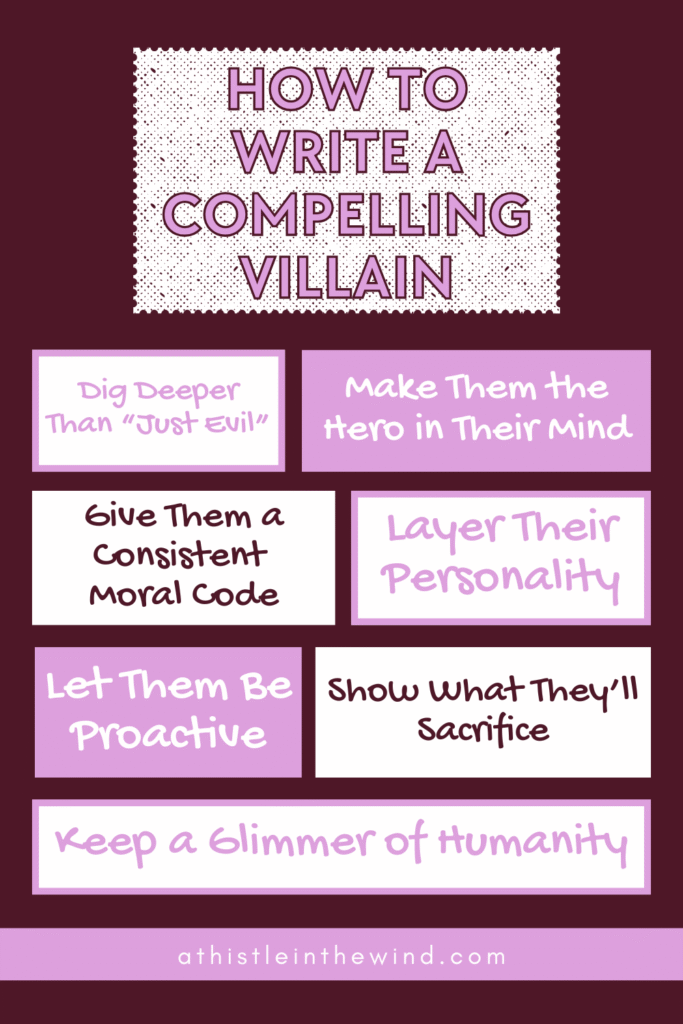
Writing the Villain’s Arc
Just like your protagonist, your villain deserves their own journey. They’re not there just to show up when it’s convenient and then disappear until Act Three. They’re living their own story—your hero is simply getting in the way.
A good villain arc isn’t always about redemption. Sometimes it’s about escalation. Sometimes it’s a slow unraveling. And sometimes it’s the tragic confirmation that yes, they were always going to be this awful.
Here are a few ways you can think about a villain’s arc:
1. The Downward Spiral
This is the classic “villain origin story.” Maybe they start with a goal that almost makes sense—protecting someone, fixing something broken. But over time, the methods get worse. The compromises pile up. Eventually, there’s no line left they won’t cross.
Think Gollum in The Lord of the Rings—once a pitiable creature, eventually consumed completely by obsession.
2. The Unchanging Force
Some villains don’t really change—and that’s what makes them so terrifying. They’re unwavering in their beliefs, and no amount of pleading or bargaining will sway them. This kind of arc works when you want the villain to feel like an unstoppable force of nature the hero has to outwit or outlast.
Think Sauron—pure, relentless purpose from beginning to end.
3. The Redemptive Turn (Kind of)
Once in a while, a villain surprises you. Maybe they realise, too late, what they’ve become. Maybe they make a final sacrifice or show a flicker of regret. It doesn’t absolve them, but it does remind the reader they were human all along.
Think Zuko from Avatar: The Last Airbender—who starts as the main antagonist but ultimately chooses a different path.
Whatever path you choose, remember: your villain’s arc should feel inevitable. Even if they have chances to turn back, the choices they make lead them exactly where they end up. When a villain’s ending feels earned—whether it’s a downfall, a redemption, or a victory—it makes your entire story hit harder.
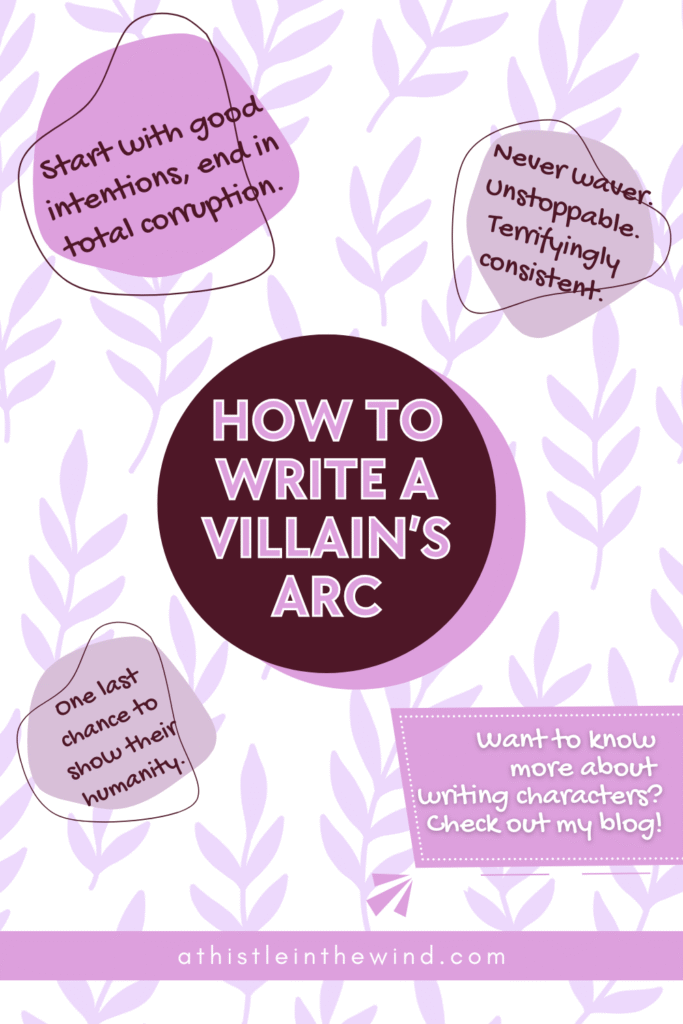
Adding Complexity to Your Villain
Even the most terrifying villains are more than just their worst traits. If you want your antagonist to stick in your readers’ minds, you have to show that they’re human (or at least human enough to be unsettling).
1. More Than Just Evil
No one is interesting when they’re just a walking collection of bad deeds. Give your villain a life beyond their villainy. What do they do when they’re not plotting world domination? Maybe they collect antique spoons. Maybe they have a soft spot for stray cats. Maybe they’re a genuinely patient mentor—just, you know, also a murderer.
Those little quirks and unexpected habits make them feel real, and honestly, a lot creepier. Because it means they could blend in. They could be your neighbor, your boss, or your best friend, if you didn’t look too closely.
2. A Pinch of Madness (Optional)
Sometimes, it helps to give your villain a touch of the unhinged—not in a “let’s stigmatize mental illness” way, but in the sense of an intensity or obsession that drives everything they do.
Maybe they’re fixated on an idea that no one else can understand. Maybe they’re so convinced of their own righteousness that any compromise feels like betrayal. That singular focus can be powerful, as long as you treat it thoughtfully and don’t turn it into a cheap stereotype.
3. A Sprinkling of Empathy
Here’s the part that makes people uncomfortable: even the worst villains can have moments that make us feel for them. Maybe it’s a flash of regret, a memory of who they used to be, or a glimpse of love they can’t quite shake.
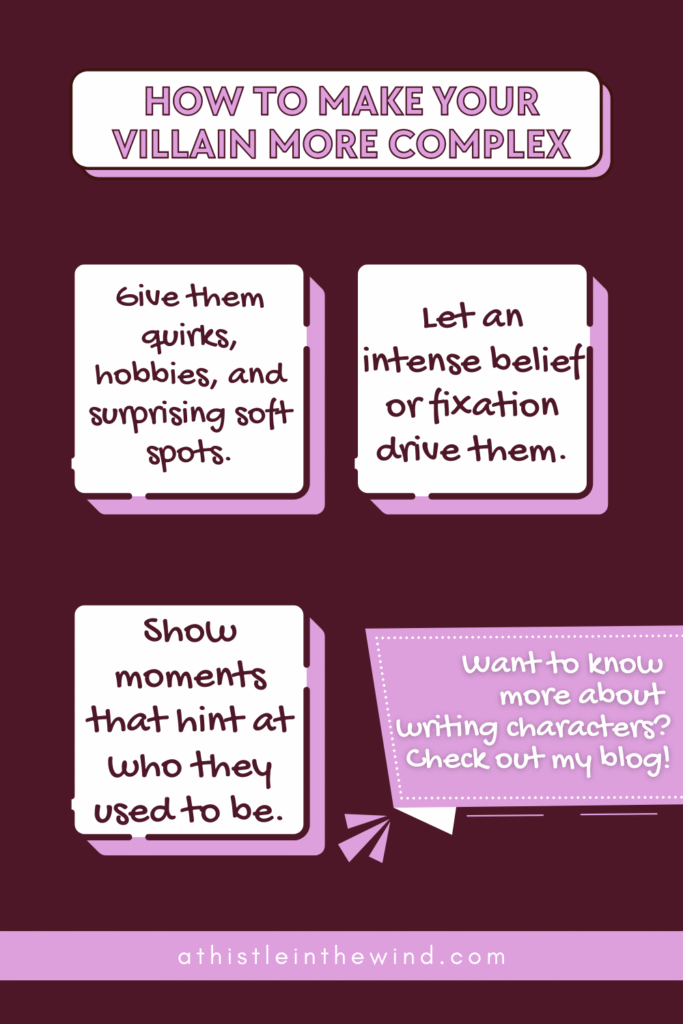
Beyond the Typical Villain
Not every story needs a cackling nemesis in a black cape. Sometimes, the thing standing in your protagonist’s way isn’t a single person at all. Other times, the hero and the villain are actually the same person. Here are a few ways to think beyond the usual Big Bad:
1. When the Antagonist Isn’t a Person
Antagonism can come from almost anywhere. It doesn’t always look like a villain plotting in a lair:
- Internal Antagonism: Sometimes, the biggest obstacle is inside your protagonist. Maybe it’s a fear they can’t shake, a lie they believe about themselves, or an addiction that keeps dragging them back to square one. These stories tend to be quieter and more character-driven, but they can hit just as hard as any showdown with an external enemy.
- Group or Societal Antagonism: Your villain might be an entire system—a corrupt government, a rigid family structure, or a culture that refuses to let your protagonist be who they are. In these stories, the antagonist isn’t just one person to defeat. It’s an environment to escape or change.
- Abstract Forces: Sometimes, the villain is something you can’t punch: grief, time, fate, or even nature itself. The challenge here is to make that abstract force feel tangible by giving it consequences your protagonist has to confront head-on.
2. When the Protagonist Is the Villain
Maybe your hero and your villain are the same person. Maybe they’re a criminal whose story you’re telling from the inside out, or an anti-hero on a collision course with total moral collapse. In these cases, you can keep readers invested by:
- Showing how they justify their actions (even when those actions are terrible).
- Giving them worse antagonists to clash with so their own darkness feels—comparatively—like something we can root for.
- Letting them wrestle with whether redemption is even possible.
Stories like The Godfather, Dexter, or Breaking Bad work because they don’t shy away from the truth: sometimes the most fascinating characters are the ones who are their own worst enemy.
Common Pitfalls to Avoid
Even when you have the best intentions, it’s surprisingly easy to write a villain who feels flat or unintentionally ridiculous. Here are a few pitfalls to watch out for while you’re plotting your grand antagonist’s evil schemes:
1. The Cardboard Cutout
If your villain only exists to cackle and monologue about how much they love being evil, congratulations—you’ve created a cartoon, not a character. Even the most despicable antagonists need believable motives, emotional logic, and something that makes them feel like an actual person.
2. Over-the-Top “Evil” Dialogue
We’ve all read it: the villain who talks like they wandered out of a 19th-century gothic novel. Unless the rest of your characters speak that way too, it’s going to feel like they’re in the wrong story. Your villain’s voice should reflect their background, personality, and world—just like everyone else’s.
3. The Lazy Backstory
If your villain’s entire motivation boils down to “they were born bad” or “someone was mean to them once,” it’s not going to cut it. Readers expect nuance. Dig deeper into what shaped them and why they genuinely believe their actions are justified.
4. Villainizing Mental Illness
Be careful not to equate “madness” with mental health struggles. Yes, your villain can be obsessed, unhinged, or operating outside social norms—but don’t lean on stereotypes that demonize real conditions. If you’re going to explore instability, do it thoughtfully and with respect.
5. Making Them Weirdly Incompetent
Nothing deflates a story faster than a villain who somehow never succeeds at anything. Give them wins—small or big—that prove they’re a real threat. A villain who always fails isn’t scary. They’re just embarrassing.
6. Forgetting Their Humanity
Even if your villain is absolutely awful, don’t forget to show glimpses of their softer side—love, fear, regret, hope. Those moments don’t make them any less dangerous. If anything, they make them more compelling.
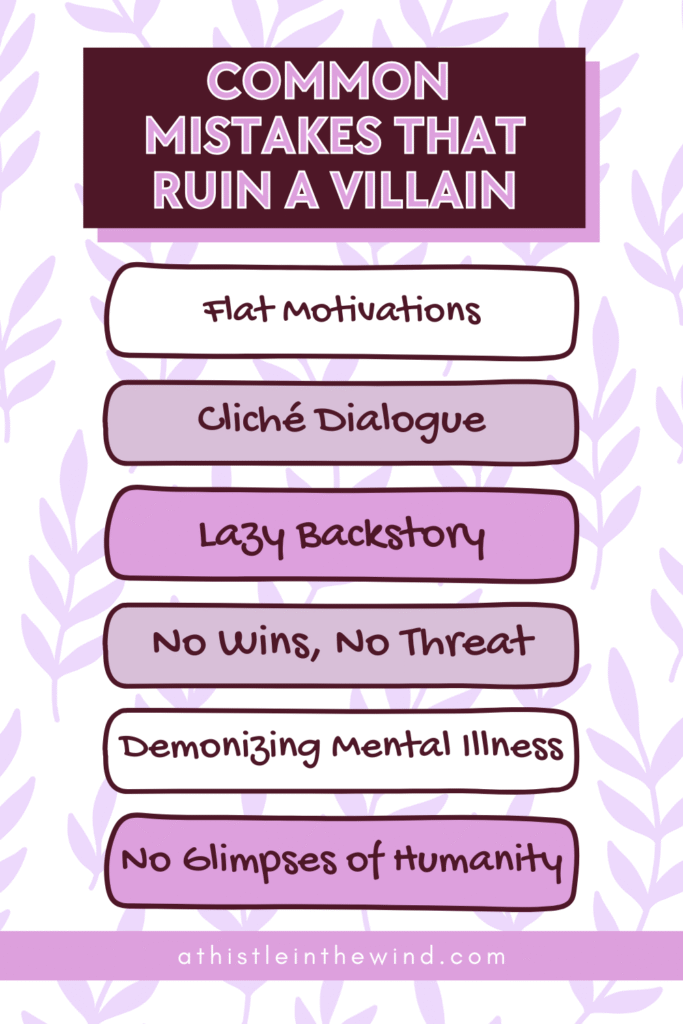
Don’t Forget to Make Them Uncomfortably Real
So, that’s pretty much everything I wanted to say about villains—and honestly, we’ve only scratched the surface.
TL;DR: The most compelling villains aren’t the ones who cackle the loudest or commit the most dramatic crimes. They’re the ones who feel real. The ones whose motives almost make sense, whose flaws feel unsettlingly human, and whose choices leave you wondering what you’d do in their place.
So, give your villains depth. Let them have convictions, contradictions, and tiny, inconvenient bits of softness they’d rather pretend don’t exist. Make them complex enough that your readers can’t dismiss them as just “the bad guy.”
And if you want more writing ramblings, here are a few posts you might find useful:
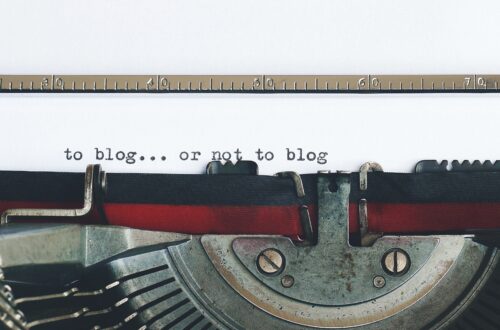
One Comment
Emily
I am only commenting to make you understand what a impressive experience my cousin’s girl enjoyed reading yuor web blog. She picked up lots of things, not to mention how it is like to have a great coaching heart to make many more with no trouble gain knowledge of several complicated things. You undoubtedly did more than people’s expectations. Thanks for coming up with those valuable, trusted, informative not to mention unique thoughts on this topic.